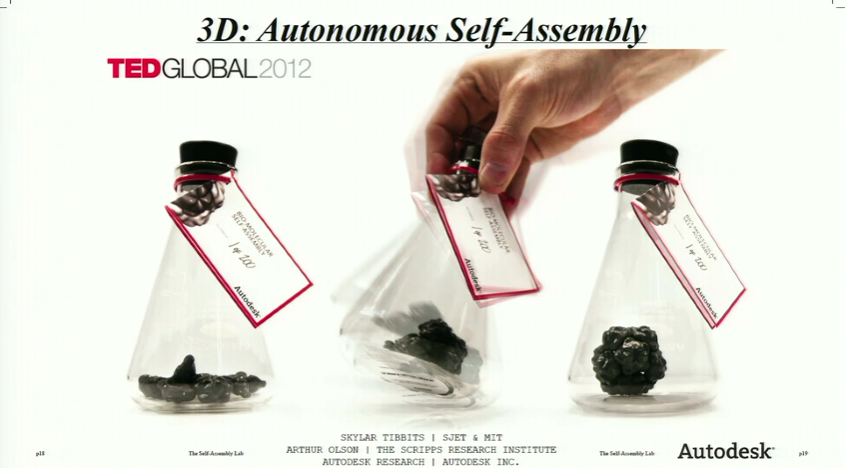In three dimensions, we did a project last year at TED Global with Autodesk and Arthur Olson where we looked at autonomous parts -- so individual parts not pre-connected that can come together on their own.
對于三維系統,我們去年在TEDGlobal和Autodesk(歐特克)以及Arthur Olson做了一個項目,我們研究了分散獨立的零件——就是怎樣讓各自分散的部分自發的組合在一起。
And we built 500 of these glass beakers.
我們一共做了500個這樣的燒杯。
They had different molecular structures inside and different colors that could be mixed and matched.
里面有不同的分子結構以及不同的可以相互混雜搭配的顏色。
And we gave them away to all the TEDsters.
我們把它們給了所有在場的TED觀眾。
And so these became intuitive models to understand how molecular self-assembly works at the human scale.
這些形象的模型幫助我們在宏觀上理解分子是如何自我組裝的。
This is the polio virus. You shake it hard and it breaks apart.
這個是脊髓灰質炎病毒。你使勁兒一搖,它就散架了。

And then you shake it randomly and it starts to error correct and built the structure on its own.
然后你隨便搖瓶子,它就開始糾錯然后自己組合成本來的結構形狀。
And this is demonstrating that through random energy, we can build non-random shapes.
這個例子說明了我們可以利用不規則的運動能量形成規則的物體形狀。
We even demonstrated that we can do this at a much larger scale.
我們甚至證明了它同樣適用于更加宏觀的層面。
Last year at TED Long Beach, we built an installation that builds installations.
去年在TED的 Long Beach,我們做了一個可以制造其它設備的裝置。
The idea was, could we self-assemble furniture-scale objects?
想法就是我們能不能自我組裝家具大小的物體呢?
So we built a large rotating chamber, and people would come up and spin the chamber faster or slower, adding energy to the system
所以我們做了一個大的滾動的空間,然后人們過來或快或慢的滾動它來給這個系統增加能量,
and getting an intuitive understanding of how self-assembly works
從而更形象的理解了自我組裝是怎么一回事,
and how we could use this as a macroscale construction or manufacturing technique for products.
以及我們怎樣在產品的宏觀建設或制造技術上利用它。












